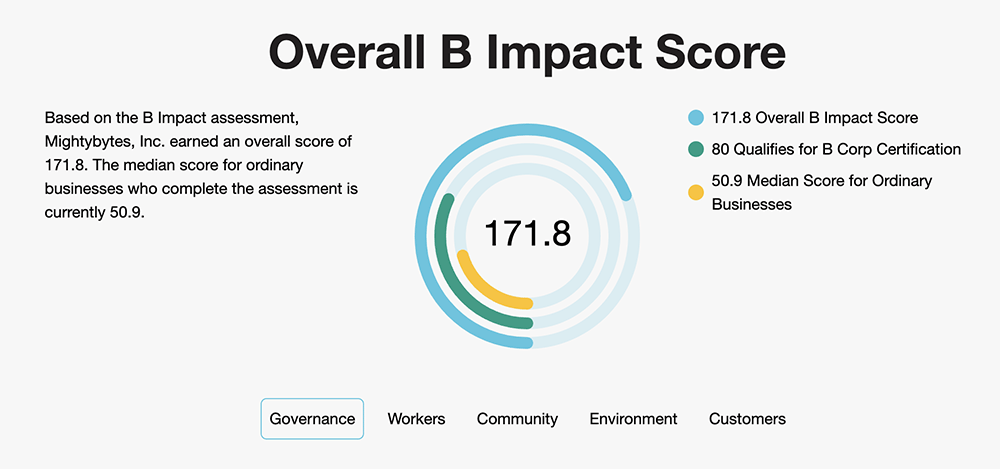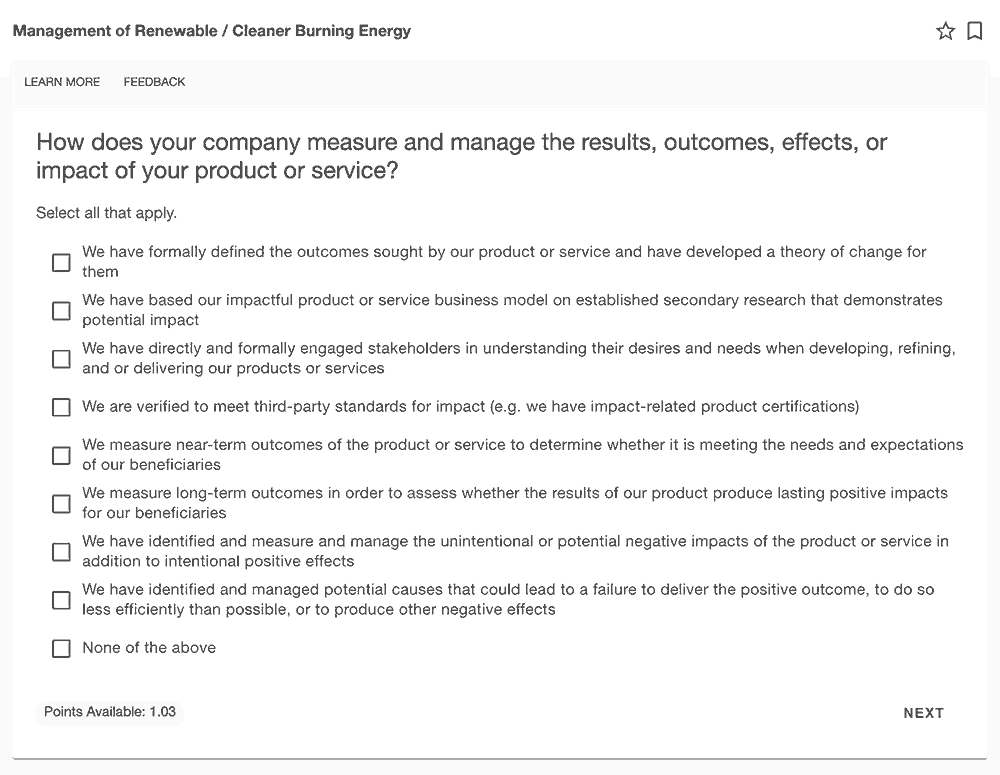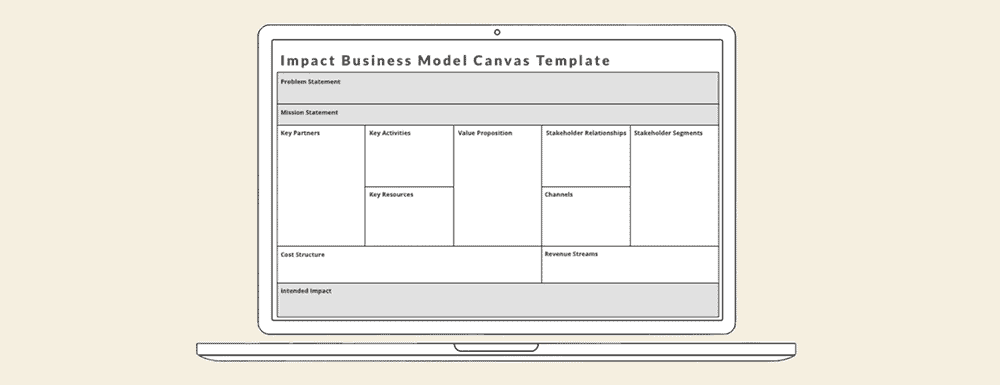How to Design an Impact Business Model
An Impact Business Model (IBM) helps organizations better align business operations with social and environmental impact. In this post, we explore how you can design an IBM for your organization.
By far, the biggest point jump we’ve seen in our B Corp certification journey is when we designed and adopted several impact business models. During our last recertification, we finished the assessment with a score of 171.8.

For reference, a score of 80 is required to become a Certified B Corp. Our first certification score in 2011 was 84. We’ve since completed the process six times.
Let’s explore how IBMs can drive positive social and environmental impact into a company’s DNA in meaningful ways.
A company with an Impact Business Model is intentionally designed to create a specific positive outcome for one of its stakeholders – such as workers, community, environment, or customers.
— B Impact Assessment
What is an Impact Business Model?
An IBM explicitly ties a company’s ability to generate revenue with some sort of benefit to stakeholders. For example:
- Illinois benefit corporation Aspiritech hires neurodiverse individuals on the autism spectrum to conduct software quality assurance testing.
Stakeholder beneficiary: workers
- Certified B Corp insurance company Vonzella partners with community organizations to reinvest policy proceeds.
Stakeholder beneficiaries: customers and communities
- Certified B Corp Tablas Creek Vineyards uses a closed-loop approach to regenerative farming while also encouraging worker ownership.
Stakeholder beneficiaries: workers and the environment
- At Mightybytes, among other things, we design and build accessible websites that also adhere to sustainable web design principles.
Stakeholder beneficiaries: communities and the environment
Companies that employ IBMs are built for longevity and resilience. Plus, because their business models directly benefit stakeholders, these companies are often more attractive to work for, buy from, invest in, and partner with. Studies have shown that many of these companies also outperform their more traditional peers over time.
IBMs can be designed into any organization’s products, services, policies, or programs. However, this requires intentionality and a clear understanding of how to create shared value for different stakeholder groups. This is challenging for some organizations.
To fully realize our potential to improve the world in which we live, we will need better tools, entities, and financial structures so that all of our available resources can be harnessed for good. Corporations and investors should see making a contribution to society as a nonnegotiable requirement. Nonprofits and donors should see sustainable business models as essential for scaled impact. But beyond the natural evolution, we will also need revolution in the form of new hybrid mechanisms intrinsically designed to bring the best of both worlds together.
— Ann Mei Chang, Lean Impact
Catching Our IBM Stride
Designing a successful IBM at Mightybytes took several years. When we first became a Certified B Corporation, our business model was far afield from our impact efforts. For example, philanthropy only happened when extra profit existed, which—for an agency focused on working with nonprofits and social enterprises—was not often.
To achieve our impact goals, we initially did what many agencies do: we offered pro bono work. Running gratis projects for small nonprofits was how Mightybytes initially built up our portfolio in the company’s early days, so this seemed a natural fit.
However, there was a dark side to this well-intended approach.
Corporate Philanthropy and the IBM
As a service-based business, our misguided approach—steeped in traditional philanthropic business practices—led to poor decisions on behalf of the company and some of its stakeholders:
- Once committed, we were on the hook to execute the pro bono projects regardless of whether or not we had the time or resources to do so.
- Because so many of our clients are nonprofits and social enterprises, this work chipped away at already slim company margins. Yet there was still a hard cost to execute each pro bono project.
- For the same reasons, our altruistic approach to philanthropy eventually spilled over into paid projects, undermining profitability and overservicing clients relative to our payment for work delivered.
Ultimately, we overextended already stretched resources, which threw the company into an existential crisis. We were doing great work for an impressive range of impact-focused organizations. However, the business model in this approach didn’t make our efforts self-sustaining for the long-term.
As a then 18-year old company—five of those as a Certified B Corp—we were still trapped in traditional late-stage capitalism ways to run a business, even though we had publicly committed to a more innovative approach. I’ve since learned that this is quite common among companies in the early stages of their impact journeys.

Redesigning the Organization with IBMs at the Core
To fix these existential problems, we decided to redesign the business with IBMs at its heart:
- We needed new, more sustainable ways to create positive social and environmental impact in our products, services, and policies.
- The company needed to be more intentional about its philanthropy.
- Communicating these new practices with stakeholders had to be an ongoing priority.
We employed a variety of methods to do this:
- B Lab’s B Impact Assessment (BIA) helped us set the goals.
- Design Thinking and other human-centered design practices helped us achieve them.
- Lean/agile processes grounded in collaboration and continuous improvement helped us evolve over time.
While it was initially a challenging transition, over time the company stabilized thanks to these efforts. We improved our financial solvency, created a better company culture, and earned Best for the World awards from B Lab several years in a row.

Elements of an Impact Business Model
IBM-related questions in the B Impact Assessment cover how a company measures and manages results, outcomes, and effects of a product or service’s impact. They include:
- Theory of Change: How will you define the outcomes you seek to achieve through your IBM? What impact do you want to create?
- Secondary Research: How will you ensure that your IBM is grounded in research that demonstrates potential impact?
- Engaging Stakeholders: How will you engage key stakeholders in developing and delivering these products or services?
- Third-Party Verification: Can you validate that your product or service achieves desired outcomes through a third-party certification?
- Impact Measurement: How will you measure both short- and long-term impacts of your product or service to achieve the desired outcomes defined in your Theory of Change?
- Failure and Negative Impacts: Have you evaluated, identified, and managed the potential negative impacts of your product or service? How will you manage the consequences if it fails?
Companies looking to incorporate IBMs into their products or services will need to document each process mentioned above, preferably by including key stakeholders as part of the co-creation process. They will also need to design revenue models to ensure products or services can be delivered profitably.
Theories of Change Driving Our Impact Business Models
Given Mightybytes’ longstanding history as a veteran digital agency and Certified B Corp, we designed three IBMs:
- Sustainable Web Design: We incorporate sustainability principles into all web design services we offer to clients. View our Sustainable Web Design Theory of Change.
- Digital Accessibility: The products and services we create adhere to Web Content Accessibility Guidelines, level “AA”. View our Accessibility Theory of Change.
- Education: We help our clients better understand emerging digital and sustainability practices through books, webinars, workshops, and other materials. View our Education Theory of Change.
These IBMs have been incorporated into our operations, finances, marketing, and culture. They are core to how we tell our impact story as well.
Mission-oriented goals tend to be vaguely worded, along the lines of “reduce poverty,” “tackle injustice,” or “fight climate change.” These are all worthy aspirations, but in the absence of a clear timeframe or measure of success, how do we know if we’re making enough progress? Are we setting our ambitions high enough? What level of risk is appropriate?
— Ann Mei Chang, Lean Impact
5 Things to Consider When Designing an IBM
Six years into redesigning our business model to focus on impact, we’re still tweaking the settings. As we learn new ways to deliver value to stakeholders, we incorporate these methods into the company’s products, services, policies, and practices. This is healthy and improves Mightybytes’ resiliency, which is critical in these disruptive times.
With this in mind, here are five things to consider when designing your own IBM:
1. Embrace innovation
As overused as the term is, innovation in product or service design is a known practice that can uncover opportunities to create value within an organization. Processes like design sprints or shorter problem framing and discovery workshops help organizations understand and identify potential impact-related innovation possibilities.
Unfortunately, many organizations still struggle to incorporate these elements into ongoing business practices with any regular cadence. This undermines their ability to more effectively blend purpose and profit long-term.
2. Redesign company practices and processes for impact
Existing products, services, policies, or practices most likely represent your organization’s lowest-hanging fruit. How might you identify impact opportunities buried within? Be specific.
For example, providing our customers with a web hosting service that uses renewable energy was a no-brainer for us.
To jumpstart your own IBM, assess existing company practices first to see what could evolve.
3. Use philanthropy as a chance to innovate
Philanthropy is a wonderful thing. However, it is often not self-sustaining for either grantor or grantee. How might you identify opportunities within your organization’s existing philanthropy practices to redesign them for more impact?
For example, by becoming a 1% for the Planet member, Mightybytes revamped company philanthropy practices to address some of the problems noted above. We also reimagined the idea of pro bono time to focus on internal impact projects like Ecograder, Sustainable Web Design, and others. We then showcase these projects in our annual impact report. This approach is lower risk and creates more clearly defined boundaries and expectations.
Similarly, many nonprofits have embraced IBMs to transition to social enterprises with clear revenue models. Are there opportunities for your organization to do something similar?
4. Create strategic partnerships
Find partners who can augment your impact efforts with their own expertise. This is especially critical for organizations just getting started on their impact journeys.
For businesses, this might mean identifying nonprofit partners with specific impact expertise the company doesn’t possess. For nonprofits, the reverse might be true.
How you do this will largely depend on the types of products or services you provide. Start there.
5. Test and learn
It is human nature to overplan. We want to head off all potential risks or problems long before they occur. However, this isn’t always realistic or achievable. Sometimes, overplanning is itself the problem. By the time we realize this, it is often too late.
Use lean/agile practices to create small learning experiments that constantly move you toward a more impactful and effective IBM. This will help you stay focused on what matters. It also won’t happen overnight. In fact, it won’t end at all. And that’s okay.

IBM Resources
Still interested in designing your own IBM? Great! The resources below can help.
Models of Impact Game
IBMs might sound boring to those outside the C-suite. However, stakeholder engagement throughout the organization is critical to IBM success. Verynice’s Models of Impact game can help onboard stakeholders while also engaging them in the co-creation process.
Filled with fun activities, Models of Impact helps players explore a cross-pollination of ideas that catalyze IBM creation in the name of a product, service, or initiative. Plus, you can play the game in just a few hours.
Impact Business Model Canvas
Stanford University’s Impact Business Model Canvas includes a variety of blocks meant to help business leaders design an IBM. From problem statements and value propositions to cost structures and intended impact, the canvas can help you craft effective business strategies that blend purpose and profit.
B Lab’s IBM Documentation Tips
The B Impact Assessment’s knowledge base includes a great post about how to successfully document an Impact Business Model. It includes tips for products, services, and organizational practices along with sample questions from the BIA. The post also includes a downloadable PDF with practical IBM tips.
Design Your Own Impact Business Model
With all this in mind, if IBMs are so valuable, why isn’t everyone incorporating them? Well…
- Because they’re focused on multiple stakeholders, IBMs are often more challenging with many moving parts to consider beyond just “following the money”.
- In many countries, legislation hasn’t evolved to prioritize this way of doing business over extractive and exploitative capitalism.
- Also, many business and nonprofit leaders are still stuck in an outdated way of thinking about how to run their organizations.
However, it doesn’t need to be this way. Hopefully, the ideas and resources shared in this post can help you evolve your own organization to operate in a more effective, purposeful, and impactful way.
Finally, if you’d like to explore designing an Impact Business Model for your own organization, try the resources mentioned above. Start with the Impact Business Model Canvas.
Questions? Give us a shout. We’d love to chat.
Check out our Latest Impact Report
Learn how Mightybytes creates shared value for people and planet.
Read the Report